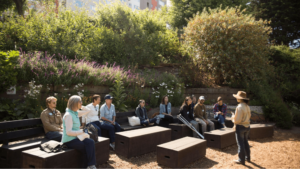People attend attractions like fairs, pop-up events, and shows to spend quality time with family and friends — but their enjoyment doesn’t have to be at the cost of our planet and community. In fact, 78% of Americans are striving to be more eco-friendly, which means that planning sustainable events is more important than ever.
Creating a sustainable event is clearly top-of-mind for event creators, and the more people who come to your attraction, the more of an impact it can have on the environment. In 2020, 59% of event planners we surveyed believed that sustainability at their events was important, compared to only 6% in 2019. If you’re ready to commit to sustainability, here are six approaches to get you started.
1. Choose a sustainable attraction venue and location
Creating a sustainable event starts with finding a venue or location that shares your eco-friendly values, such as a LEED-certified venue. Locations with LEED certification follow specific standards that make them more energy efficient. If you can’t use a certified location, ask local venues about ways you can reduce your carbon footprint at the event instead.
Don’t forget about transportation to and from your venue. Vehicle emissions are a primary source of greenhouse gases, so encourage attendees to carpool, walk, bike, or take advantage of public transportation services. Renting a bus or similar vehicle can be costly, but it’s a good way to reduce the number of cars on the road — and in the parking lot.
2. Offer recycling and composting at your event
Keep your event green on the day-of by offering recycling and — if your city has a program in place — composting stations. Be sure to clearly label the bins so guests know what goes where and, of course, empty them regularly.
Cut back on the amount of waste even further by:
- Encouraging guests to bring reusable totes, cups, etc.
- Using repurposed or upcycled décor
- Using reusable name badges
- Renting composting toilets
3. Work with a sustainable event caterer
If you’re serving food and drinks at your event, you’ll want to work with vendors who also care about the environment. Choose food and drink partners who use locally grown, fresh, or responsibly sourced ingredients and eco-friendly dinnerware. When setting the menu, take different dietary needs into account. According to our Industry Trends Report, around 46% of event organizers report receiving memos on the importance of offering vegan and vegetarian dishes.
Your event can give back to the community by donating any unopened food items to a local organization for redistribution — just make sure to review local restrictions and give to a verified organization. Look for a local composting company to take any leftover fruits and veggies.
4. Rethink your attraction swag
Everyone loves freebies, but the last thing you want is for your swag to end up in the trash. Instead of giving away the same old keychains with the company logo, start thinking about sustainability. What’s something that your attendees will genuinely want to use? Can you find gifts that are made with integrity? Locally sourced swag can be found at maker markets or bought from local artists and businesses.
Not all swag is physical — consider these digital freebies, too:
- Downloadable resources like catalogs, recipes, or ebooks
- Subscription deals or free trials for streaming services or apps
- Discount codes for vendors and local establishments
Check out our event swag infographic for more eco-friendly ideas.
5. Reduce your attraction’s paper trail
Sending out flyers, newsletters, and event programs and using paper tickets can create a long paper trail for your event. You can make your event more sustainable by transitioning to digital communications and marketing. Connect with attendees via Eventbrite Boost and use Eventbrite Organizer’s digital ticketing feature. E-tickets have the added perk of being harder to lose and quicker to scan at check-in — that’s why almost 90% of event planners have adopted them.
Consider these other ways of reducing the need for paper at your attraction:
- Create a website and app for the event
- Use email and social media channels to announce and promote your event
- Choose recycled products and packaging when possible
6. Teach your attendees about sustainability
Your eco-conscious attendees will appreciate your efforts at sustainability, but the work doesn’t end there.
Make the most out of your sustainable efforts by letting attendees know about them. Use signage to highlight and encourage sustainable practices. You can also include eco-friendly tips and information about meal options and sustainable practices in your marketing materials. Include this information in your Eventbrite event listing too — it may attract even more attendees.
Learn more sustainable approaches for your attraction
Implementing these sustainable practices in your next event will not only benefit the earth and your community, but it will also position you as an eco-friendly brand. Need inspiration? Check out our favorite sustainable events examples for ideas for your next attraction.






